I am Mayra Pelagio, first year student at UC Davis working towards an Environmental Science and Management degree. As a first year, I felt a little lost in the huge campus and I was eager to find an area of interest that will help me distress from school work. Thankfully, a friend of mine knew about Sara’s project and that she was looking for interns. The few months I was in the project were really exciting and I learned a lot about birds and agriculture. My blog post is about my experience as an intern.
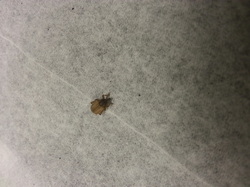 Adult weevil found in samples
Adult weevil found in samples The Alfalfa experiment
If you were to go out on a field to count birds in any given day, you would be amazed by the amount and variety of bird populations. This is true for alfalfa fields. Many farmers might see birds such as the red-winged blackbirds, and Brewer’s blackbirds as pest species and might considered the use of bird deterrents or even poisons to control their populations. Whereas they might recognize that birds like barn swallows are insect-eaters and may help crops. The purpose of the experiment is to see if birds are helping farmers. Since birds don’t eat alfalfa, the idea is that such birds are on the fields looking for insect food: alfalfa weevils specifically.
Alfalfa weevils are considered one of the most damaging insects to alfalfa. As larvae, the alfalfa weevils feed on alfalfa branches, significantly decreasing the yield of the crop.
If you were to go out on a field to count birds in any given day, you would be amazed by the amount and variety of bird populations. This is true for alfalfa fields. Many farmers might see birds such as the red-winged blackbirds, and Brewer’s blackbirds as pest species and might considered the use of bird deterrents or even poisons to control their populations. Whereas they might recognize that birds like barn swallows are insect-eaters and may help crops. The purpose of the experiment is to see if birds are helping farmers. Since birds don’t eat alfalfa, the idea is that such birds are on the fields looking for insect food: alfalfa weevils specifically.
Alfalfa weevils are considered one of the most damaging insects to alfalfa. As larvae, the alfalfa weevils feed on alfalfa branches, significantly decreasing the yield of the crop.
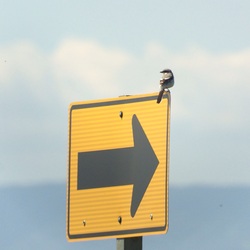 Loggerhead Shrike. Photo by Sara.
Loggerhead Shrike. Photo by Sara. In the fields
The team of interns and Sara built exclosures to keep the birds away from the area of study, and the areas covered by these exclosures were the treatment space. Each field has two treatment and two control areas from which alfalfa samples were taken. The work on the field usually consisted of checking on the exclosures and harvesting the alfalfa. Farmers calculate their gains depending on the alfalfa yield and we mimicked the process of production by collecting the samples, processing them to identify the weevil population on them and then drying them to observe the resultant yield. The expected results were to have more weevils in the areas birds didn’t have access to.
The team of interns and Sara built exclosures to keep the birds away from the area of study, and the areas covered by these exclosures were the treatment space. Each field has two treatment and two control areas from which alfalfa samples were taken. The work on the field usually consisted of checking on the exclosures and harvesting the alfalfa. Farmers calculate their gains depending on the alfalfa yield and we mimicked the process of production by collecting the samples, processing them to identify the weevil population on them and then drying them to observe the resultant yield. The expected results were to have more weevils in the areas birds didn’t have access to.
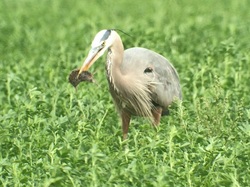 Great Blue Heron with a vole. Photo by Mayra.
Great Blue Heron with a vole. Photo by Mayra. Bird Watching
While on the fields, Sara and I had various opportunities to observe several birds, especially at the beginning of spring when some birds where laying eggs and for others, eggs were hatching. There were some pretty awesome birds we saw that I’d like to talk about.
Birds observed
The Great horned owl; we saw a female at about midday, sitting in a nest with her great yellow eyes looking right at us. She was beautiful, and from the observations Sara concluded that she was incubating.
Great egrets and Great blue herons; this was perhaps the most amazing bird watching experience for me. On a field day, we noticed an alfalfa field (not part of the experiment) that was full of great egrets and great blue herons. The field was being flood-irrigated and as we later discovered, it was infested with voles. We stayed there for only a few minutes but in that time we witnessed several birds swallowing voles whole!! Some of them ate the prey right way, others kept it in their beaks for a little longer to completely kill the animal. I had never witnessed birds hunting in such environment and it was such a great experience.
While on the fields, Sara and I had various opportunities to observe several birds, especially at the beginning of spring when some birds where laying eggs and for others, eggs were hatching. There were some pretty awesome birds we saw that I’d like to talk about.
Birds observed
The Great horned owl; we saw a female at about midday, sitting in a nest with her great yellow eyes looking right at us. She was beautiful, and from the observations Sara concluded that she was incubating.
Great egrets and Great blue herons; this was perhaps the most amazing bird watching experience for me. On a field day, we noticed an alfalfa field (not part of the experiment) that was full of great egrets and great blue herons. The field was being flood-irrigated and as we later discovered, it was infested with voles. We stayed there for only a few minutes but in that time we witnessed several birds swallowing voles whole!! Some of them ate the prey right way, others kept it in their beaks for a little longer to completely kill the animal. I had never witnessed birds hunting in such environment and it was such a great experience.
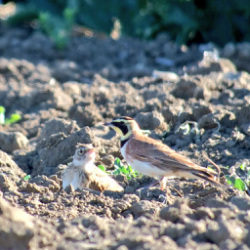 Horned lark with chick. Photo by Sara.
Horned lark with chick. Photo by Sara. Loggerhead shrike; this is a small songbird that preys like a raptor. We got to see this little bird and part of its nest one day while we were in the fields. The loggerhead shrike is one of the few song birds that have the ability, or rather the beak, to prey for large insects and other bigger animals.
Horned Lark; we saw this little guy near a tomato field. Horned Larks have a distinct black-colored frown that makes the bird look mad, even sad. They are beautiful nonetheless.
Other birds that I managed to identify were; king birds, American robins, Western scrub jays, golden crowned sparrows, California quail and over fifty other species. As a first timer, I had seen plenty of birds but never really knew their species, now I am able to identify them and in some cases know more than just their names.
Horned Lark; we saw this little guy near a tomato field. Horned Larks have a distinct black-colored frown that makes the bird look mad, even sad. They are beautiful nonetheless.
Other birds that I managed to identify were; king birds, American robins, Western scrub jays, golden crowned sparrows, California quail and over fifty other species. As a first timer, I had seen plenty of birds but never really knew their species, now I am able to identify them and in some cases know more than just their names.
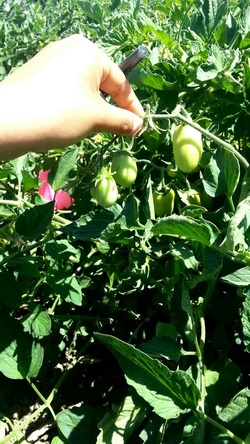 Checking tomatoes for damage. Photo by Mayra.
Checking tomatoes for damage. Photo by Mayra. Lab work
The processing of alfalfa was quiet tedious. After we harvested the field, we would end up with an alfalfa sample that we were to process and dry to obtain the yield. In the lab, we took a plastic container, put all the alfalfa in it and shook it for at least thirty times to knock the insects off the plants. After was done, we took the alfalfa out by handfuls and slapped the bunch against the containers walls, again to make sure the insects are off the plant. After all the alfalfa was taken out, it was weighed and the remaining leaf matter was examined for weevils. The data analysis was done on the amount and size of the weevils found. I did not have the opportunity to work with the data, but the results will be shared with me.
The tomato experiment
Due to the ending of the school year I was only able to help with the tomato experiment for two weeks. During these two weeks, we went out in the fields examining the tomato plants that were in study, following the same process as the alfalfa. The processing of the data worked differently though. The plants were examined by observation in the field and the data used was on damage reports.
I won’t be able to help this summer with the rest of the tomato or the sunflower experiments but I am hoping to come back during the winter to continue working on the alfalfa experiment.
The processing of alfalfa was quiet tedious. After we harvested the field, we would end up with an alfalfa sample that we were to process and dry to obtain the yield. In the lab, we took a plastic container, put all the alfalfa in it and shook it for at least thirty times to knock the insects off the plants. After was done, we took the alfalfa out by handfuls and slapped the bunch against the containers walls, again to make sure the insects are off the plant. After all the alfalfa was taken out, it was weighed and the remaining leaf matter was examined for weevils. The data analysis was done on the amount and size of the weevils found. I did not have the opportunity to work with the data, but the results will be shared with me.
The tomato experiment
Due to the ending of the school year I was only able to help with the tomato experiment for two weeks. During these two weeks, we went out in the fields examining the tomato plants that were in study, following the same process as the alfalfa. The processing of the data worked differently though. The plants were examined by observation in the field and the data used was on damage reports.
I won’t be able to help this summer with the rest of the tomato or the sunflower experiments but I am hoping to come back during the winter to continue working on the alfalfa experiment.
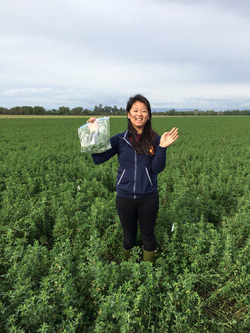
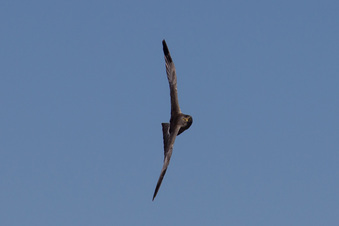
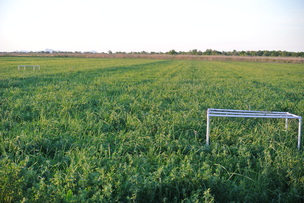
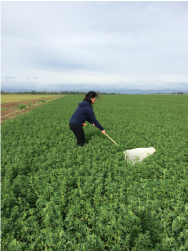
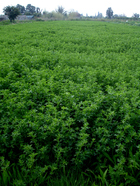
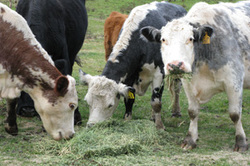
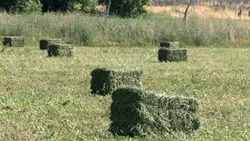
 RSS Feed
RSS Feed
